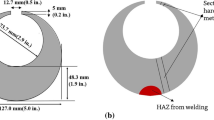Conclusions
-
1.
The hardness of dies after heat treatment does not determine the susceptibility to brittle fracture. The check on the tempering process in terms of hardness, as is done at present, is incomplete.
-
2.
The strength of dies manufactured from high-alloy steels and quenched from low temperatures can be increased by aging.
-
3.
If die steels are subjected to quenching from standard temperatures then tempering should be conducted at the highest temperatures at which the first-order stresses do not reduce the overall strength of the die.
Similar content being viewed by others
Additional information
Physicotechnical Institute of the Academy of Sciences of the Belorussian SSR. Translated from Metallovedenie i Termicheksaya Obrabotka Metallov, No. 1, pp. 72–73, January, 1972.
Rights and permissions
About this article
Cite this article
Dovnar, S.A., Butkevich, N.N. Effect of double tempering on work of fracture of die steels. Met Sci Heat Treat 14, 83–85 (1972). https://doi.org/10.1007/BF00658360
Issue Date:
DOI: https://doi.org/10.1007/BF00658360




